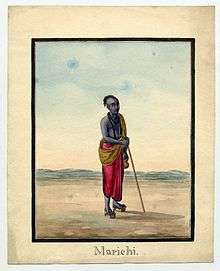Marichi
| Marichi | |
|---|---|
 Marichi, a Rishi and son of Brahma | |
| Children | Kashyapa |
Rishi Marichi or Mareechi or Marishi (ṛṣi Marīci, ऋषि मरीचि) (meaning a ray of light)) is the son of Brahma, the cosmic creator, and also one of the Saptarshi (Seven Great Sages Rishi), in the First Manvantara, with others being Atri, Angiras, Pulaha, Kratu, Pulastya, and Vashishtha.[1] In another classification, Marichi is one of the ten Prajapatis, the ruler of people created by Brahma.[2]
In Jain scriptures, he is referred to as one of the previous reincarnations of the 24th Tirthankara Mahavira as son of the Bharata Chakravartin.[3]
Saptharisihi
Saptarishi, a Sanskrit dvigu meaning "seven sages") are the seven rishis who are extolled at many places in the Vedas and Hindu literature. The Vedic Samhitas never enumerate these rishis by name, though later Vedic texts such as the Brahmanas and Upanisads do so. While earlier texts do not mention Marichi as one of the seven, references can be found in the epic Mahabharata. In some parts of India, people believe these are seven stars of the Big Dipper named "Vashista", "Marichi", "Pulastya", "Pulaha", "Atri", "Angiras" and "Kratu". There is another star slightly visible within it, known as "Arundhati".
Prajapathis
Before the creation started, Brahma, the Hindu god of creation, needed a few people who can be held responsible for the creation of the remaining Universe. Therefore, he is believed to have created ten Prajapatis (Ruler of the people) from his Manas (mind) and nine from his body. Marichi is one of the manasputras of Brahma. The ten Prajapatis are as follows:[2]
Life
The life of Marichi is known more by the account of his descendants, notably by the works of sage Kasyapa. Marichi is then married to Kala and gave birth to Kashyap (Kashyap is also sometimes acknowledged as a Prajapati, who has inherited the right of creation from his father).[2]
Krishna in the Bhagavad-Gita says, "Of the Ādityas I am Vishnu, of lights I am the radiant sun, of the Maruts I am Marici, and among the stars I am the moon."[4]
Jainism
In Jain scriptures, Marichi was the son of Bharata Chakravartin[5] who after many births was born as 24th Tirthankara of Jainism, Mahavira.[3] In his life as Marichi, he became a Jain monk following Rishabhanatha, first tirthankara, but was unable to follow the hard rules of Digambara penance. So he took a robe, pedals and an umberalla and founded his own religion taking Kapila as his first disciple.
See also
Notes
- ↑ Inhabitants of the Worlds Mahanirvana Tantra, translated by Arthur Avalon, (Sir John Woodroffe), 1913, Introduction and Preface. The Rishi are seers who know, and by their knowledge are the makers of shastra and "see" all mantras. The word comes from the root rish Rishati-prapnoti sarvvang mantrang jnanena pashyati sangsaraparangva, etc. The seven great Rishi or saptarshi of the first manvantara are Marichi, Atri, Angiras, Pulaha, Kratu, Pulastya, and Vashishtha. In other manvantara there are other sapta-rshi. In the present manvantara the seven are Kashyap, Atri, Vashishtha, Vishvamitra, Gautama, Jamadagni, Bharadvaja. To the Rishi the Vedas were revealed. Vyasa taught the Rigveda so revealed to Paila, the Yajurveda to Vaishampayana, the Samaveda to Jaimini, Atharvaveda to Samantu, and Itihasa and Purana to Suta. The three chief classes of Rishi are the Brah-marshi, born of the mind of Brahma, the Devarshi of lower rank, and Rajarshi or Kings who became Rishis through their knowledge and austerities, such as Janaka, Ritaparna, etc. Thc Shrutarshi are makers of Shastras, as Sushruta. The Kandarshi are of the Karmakanda, such as Jaimini.
- 1 2 3 Wilkins, W.J. (2003). Hindu Mythology. New Delhi: D.K. Printworld (P) Limited. p. 370. ISBN 81-246-0234-4.
- 1 2 Dundas 2002, p. 21.
- ↑ Bhagavad Gita 10.21
- ↑ Suriji, Acharya Gunaratna (2011). Confession: The Path to Self Liberation. Jingun Aaradhak Trust.
References
- Dundas, Paul (2002) [1992], The Jains (Second ed.), Routledge, ISBN 0-415-26605-X
